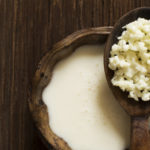Print Recipe
Nutrition Facts
Milk Kefir
Amount Per Serving
Calories 289
Calories from Fat 135
% Daily Value*
Fat 15g23%
Saturated Fat 9g56%
Cholesterol 47mg16%
Sodium 203mg9%
Potassium 625mg18%
Carbohydrates 23g8%
Sugar 24g27%
Protein 15g30%
Vitamin A 767IU15%
Calcium 535mg54%
* Percent Daily Values are based on a 2000 calorie diet.
Milk Kefir
Learn how to make kefir if you prefer a homemade approach compared to buying kefir in shops.
Servings: 1 pint
Calories: 289kcal
Equipment
- Large glass jar
- Breathable cover for the jar, such as paper towels, butter muslin or coffee filter
- Rubber band to secure the cover to the opening of the jar
- Mesh plastic strainer - used to remove kefir grains
- Wooden or plastic stirring utensil
Ingredients
- 1-2 tsp Milk kefir grains
- 1 pint goat or cow milk pasteurised
Method
- Place the active kefir grains into the milk, and no more than one pint of milk and pour into the jar
- Cover the glass jar containing the milk, and secure tightly with the rubber band
- You'll need to place to jar in a warm position to activate the culture. Ideally, place in a room with a temperature between 20-30 degrees centigrade.
- Leave in place for up to 24 hours, and until the milk has become slightly thickened and the aroma is pleasant to smell. Depending on ambient temperature, this can take less than 24 hours so keep an eye on the jar during this time.
- Using the mesh plastic strainer, remove the grains from the thickened milk culture. You can place these grains into a fresh jar of milk to continue the process of creating more homemade kefir. You can continue this process for around three to four weeks before resting the kefir grains by refrigerating them or drying them out.
- With the kefir culture complete, store the finished homemade kefir in the fridge and consume with 24-48 hours.
Notes
This recipe uses the traditional milk kefir grains as the starter culture, which are often rehydrated. Other approaches make use of a powered culture. You'll need to follow any instructions with your kefir grains on how to active them ready for use with this recipe.
This recipe uses pasturised milk. While raw milk is a popular element of kefir, this can lead to illness, especially people with lowered immune systems. If you are using raw milk, it's recommended that you activate the milk kefir grains in pasturised milk first before moving them to the raw milk.
Removing grains
Removing the milk kefir grains can be difficult, especially with over thickened kefir milk.- Use a plastic mesh strainer, with a wooden spoon or plastic spatula to help work the kefir through the strainer.
- Use a shallow bowl that is made of non-reactive metal, such as a plastic bowl, and pour the thickened milk culture from the jar into the bowl. This can help make the grains more visible and easier to spot and remove.
- Clean hands before removing grains. Don't use any soap when cleaning hands – just warm water – to avoid any contamination of the culture.
Nutrition
Calories: 289kcal | Carbohydrates: 23g | Protein: 15g | Fat: 15g | Saturated Fat: 9g | Cholesterol: 47mg | Sodium: 203mg | Potassium: 625mg | Sugar: 24g | Vitamin A: 767IU | Calcium: 535mg
